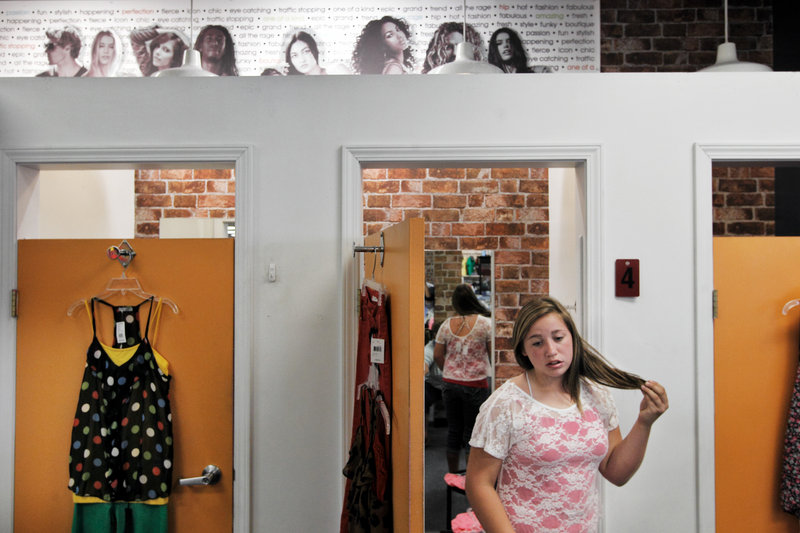In most of the small towns where Glik’s operates, J.C. Penney is a neighbor. In some cases, the retailers are just a door or two away from one another in a strip center.
That’s a good thing for Glik’s these days. J.C. Penney’s recent stumble — after it drastically reduced sales — has driven more customers to the stores next door, said Jeff Glik, chief executive of the chain of 55 apparel stores.
“They’re in such disarray right now, and we’re the beneficiaries of that,” he said. “So many consumers love the art of finding a bargain, and so they’ve gotten disappointed with J.C. Penney.”
It’s one of the reasons Glik says his company’s same-store sales have risen 8.3 percent so far this year compared to last year. Executives at Macy’s department stores also reported they’ve seen an uptick in sales in malls where there are also J.C. Penney stores.
It was a bold move by J.C. Penney: Eliminate all coupons and many special discounts and sales in favor of an everyday low pricing structure. But the chain has been discovering that shoppers are more addicted to coupons and sales than they expected. Executives still think the new strategy will pay off in the long run. But some critics are not so optimistic.
“You can’t retrain America,” said C. Britt Beemer, chairman of the America’s Research Group. “Every retailer in the country would have to get rid of sales at the same time to make that strategy work.”
Under a new chief executive, the 110-year-old retailer embarked earlier this year on a “fair and square pricing” strategy, eliminating most promotions and those popular $10 off coupons.
In response, same-store sales plummeted 19 percent for the first quarter ended April 28, compared to the like period a year ago. Store traffic dropped 10 percent.
Ron Johnson, Penney’s CEO, came to the company after engineering Apple’s wildly successful retail stores. When he came on board at the end of last year, he promised to reinvent the modern department store.
He brought on a so-called “dream team” of executives, many his former colleagues from Target and Apple, including Michael Kramer, who left Kellwood Co. to join him.
One of Johnson’s first major moves was to overhaul pricing. He noted that the company had 590 sales and promotions last year, and consumers only bought a small fraction of items at regular price.
At an investors conference last month, he said Penney’s promotional strategy had run its course. In the last decade, the company’s average price point went from $27 to $36 — a 40 percent increase. The company used bigger and bigger sales to draw customers in. Customers bought — but at a lower sale price than before. And the overall sales volume wasn’t growing, he said.
“And so over that time, you kind of lost your price integrity, and the only way to beat a sale is what? A bigger sale,” he said. “That model wasn’t working.”
The new pricing approach rolled out in February. Regular prices are now 40 percent lower than before. Then there are “monthlong values” on different products, which are discounted 20 to 30 percent off from the everyday price. And its “best prices,” or clearance prices, are rolled out on the first and third Friday of every month.
In the first-quarter conference call, Johnson acknowledged that the first 90 days had been tougher than expected. But he added that this was the year of transformation and it would take a year to see the positive results reflected.
“We’re trying to essentially convert the Titanic into 1,100 WaveRunners,” he said. “That’s really hard to do.”
Kramer, the company’s chief operating officer, told investors that coupons had been a drug that drove traffic to the stores.
“We did not realize how deep some of the customers were into this,” he said.
Many analysts say it’s no surprise that consumers love discounts and sales. Other retailers have tried and failed to pare them back. In 2006 and 2007, Macy’s tried to reduce the number of coupons it offered.
“Customers did not respond well and business suffered, so we adjusted at that point,” Jim Sluzewksi, a Macy’s spokesman, wrote in an email.
Furthermore, Penney’s customers have been conditioned over years to expect these sales and coupons, Beemer said.
“You can’t tell the world one day (that) you’re 50 to 60 percent off, and the next day tell them, ‘We’re going to be everyday low price,”‘ he said. “You would think people would listen to the consumer and give the consumer what they want instead of trying to change the consumer.”
Martin Sneider, an adjunct professor of retailing at Washington University, said Dillards and Sears have also tried to move away from sales in the past. But all of those experiments failed, too.
To be sure, mass merchants such as Target and Walmart have successfully used a one-low-price strategy. But that’s partly because consumers have a better sense of the price of items they sell, Sneider said.
“I would say my mother knew the right price for ketchup, and she knew when it went up two cents,” he said. “But she probably didn’t know the right price for a knit shirt.”
Not all analysts are as pessimistic about Penney’s new strategy. Paul Swinand of Morningstar said there is a limit to department-store promotions, and Penney is now trying to right-size the strategy. “We’ve reached a breaking point where one guy has broken ranks,” he said.
Some of the results from the first quarter show that the new pricing strategy is working, Swinand added. He was encouraged, for example, that two-thirds of customers bought items at the regular price.
“But I think what they’ve done poorly is they haven’t communicated there is still stuff on sale, but it’s just once a month,” he said. “They got a little too cute with the advertising.”
After the dismal first quarter, Penney has begun to make some tweaks. Its president in charge of marketing and merchandising stepped down last month. And analysts are more upbeat about other changes coming down the line to the department store. Penney is changing its merchandise assortment, bringing in new brands by designers such as Betsey Johnson, Cynthia Rowley and Vivienne Tam. And next year, Penney plans to roll out a new store format with a number of mini-stores in it.
Some shoppers are on board with the new pricing strategy. Selena Love of north St. Louis County goes to Penney because of its low prices on children’s clothing. She likes the changes the store has been making recently.
“I just bought six or seven outfits for less than $50,” she said. “It’s better than the clearance because it’s more organized and you don’t have to go digging through everything.”
But after the dismal first quarter, Johnson told the Wall Street Journal that he remains committed to the pricing strategy, but would work to better communicate it to shoppers.
He has also said that consumers didn’t really understand what a “monthlong value” was and so will begin calling it what it is — a sale.
Copy the Story Link
Send questions/comments to the editors.




Success. Please wait for the page to reload. If the page does not reload within 5 seconds, please refresh the page.
Enter your email and password to access comments.
Hi, to comment on stories you must . This profile is in addition to your subscription and website login.
Already have a commenting profile? .
Invalid username/password.
Please check your email to confirm and complete your registration.
Only subscribers are eligible to post comments. Please subscribe or login first for digital access. Here’s why.
Use the form below to reset your password. When you've submitted your account email, we will send an email with a reset code.